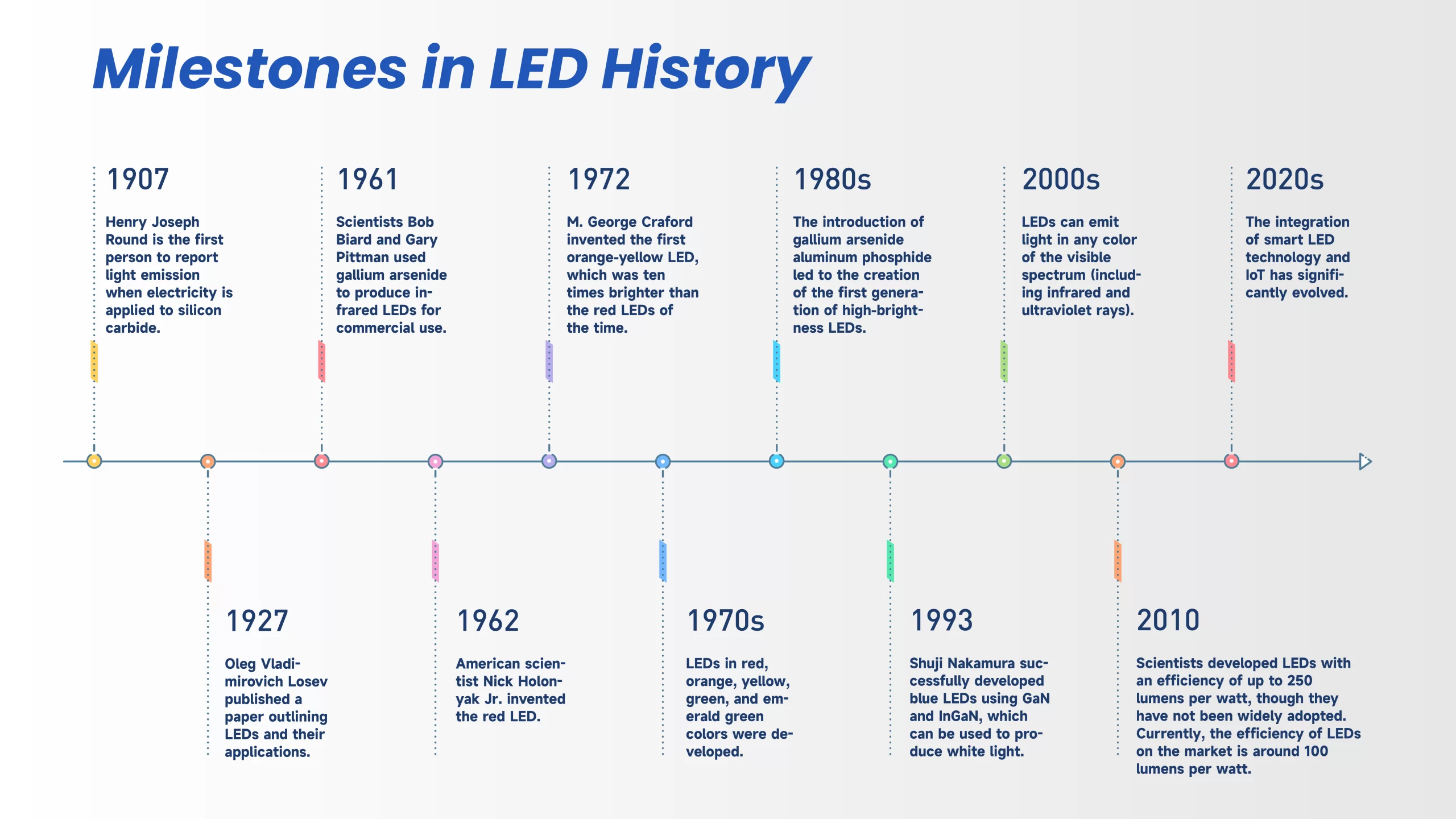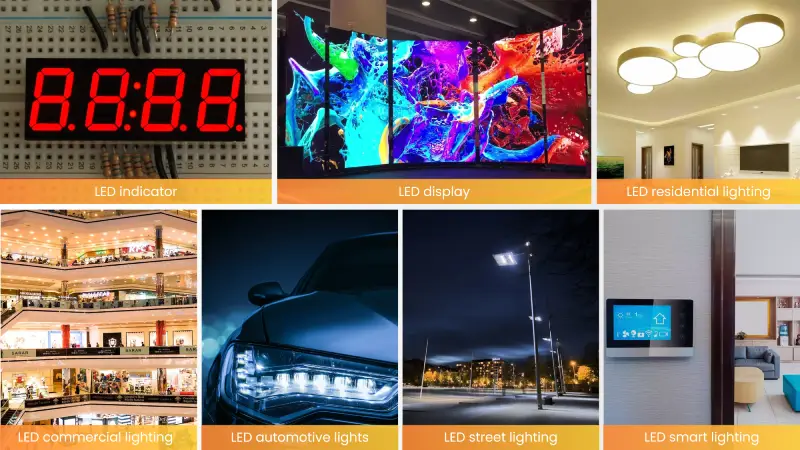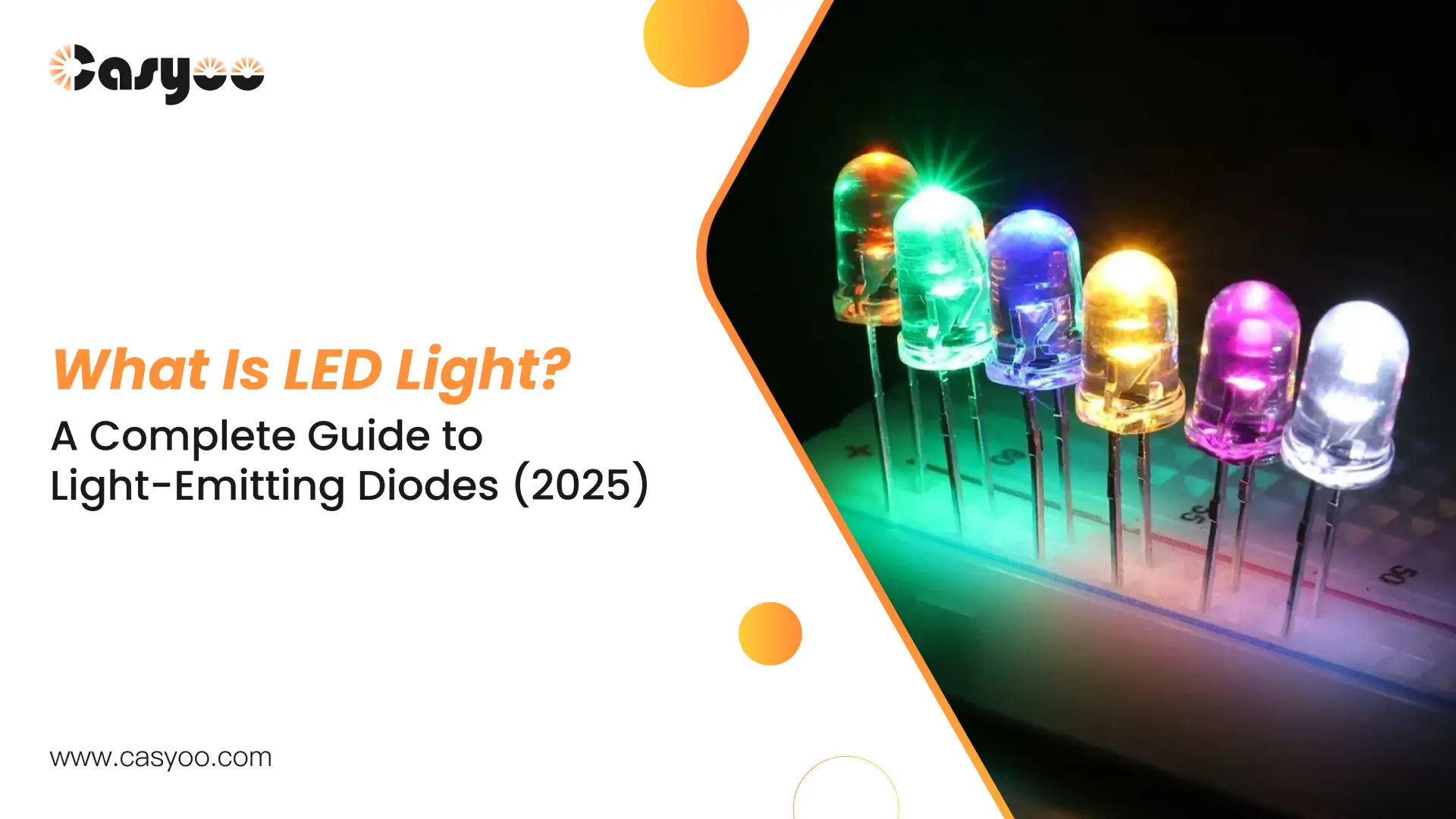Light-emitting diodes, or in their abbreviation form, LEDs, are devices that emit light as a result of producing energy caused by the recombination of electrons and holes. Light-emitting diodes first became available in 1962. Ever since then, scientists have slowly worked on developing higher-efficiency LED chips in different colors for general lighting. Compared to traditional lighting, LED lights stand out for their exceptional efficiency and eco-friendliness and are gradually replacing traditional lamps. In this article, we will explain what is LED light, how LEDs work, and why LED lights are the best choice for modern lighting solutions.
What is LED light?
LEDs represent the fourth generation of lighting technology, following the generations of incandescent lamps, fluorescent lamps, and high-intensity discharge (HID) lamps. They emit light using solid semiconductor materials and are distinguished by their quick response times, low power consumption, and extended service life. Common uses for LEDs include general lighting, display screens, automotive lighting, and indicator lights.
History of LED lights
Initially, people created LED lights, which emit invisible light. Later, scientists developed LED lights in a variety of colors and successfully brought them to life. The creation of blue light LEDs enables LED lights to emit white light, which is extremely important for the use of LEDs in general illumination. In recent times, scientists are primarily concerned with enhancing the efficiency and functionality of LEDs.

Types of different LED light colors
The energy states of electrons and holes vary among different semiconductor materials. The larger the amount of energy given off during recombination, the smaller the wavelength of light emitted. For instance, gallium phosphide and gallium arsenide diodes, for example, emit green and red light, respectively. Silicon carbide diodes give out yellow light, and gallium nitride diodes give out blue light.
LEDs are different from other conventional sources of light in the sense that they can provide a much broader range of color temperatures. The white light coming out of the LEDs can sometimes have a cool and sometimes a warm tone. Below is usually how the LED color temperature would fall:
- 3000K-4500K: This is usually a warm white light with a slightly yellowish tone. These kinds of LED lights are ideal for creating a warm and welcoming ambiance.
- 4000K-5000K: Neutral white light similar to natural daylight
- 5000K-6000K: Cold white light, mainly used for task lighting because it helps improve focus and concentration.
How do LED lights work?
A chip composed of an N-type and P-type semiconductor forms the central part of the light-emitting diode. There are numerous holes (electron vacancies) in the P-type semiconductor, and numerous free electrons in the N-type semiconductor. In between the P-type and N-type semiconductors, there exists a transition region known as the PN junction. Electrons move from the N region into the P region and holes move from the P region into the N region when a forward voltage is applied across the PN junction. When emitting light, some of the minority carriers that move into the other region—such as electrons that move into the P region—recombine with the majority carriers.
LED light technology
In this section, we look at LED technologies from several eras to show the evolution of LED lighting. Then we’ll go over the LED production process. To help you understand how LED technology is used in everyday life, we will introduce some practical applications of LED lights.
The evolution of LED light technology
Scientists have made many efforts to invent better LED lights, such as experimenting with different semiconductor materials, enhancing LED chip structures, and introducing a wider range of colors and adjustable color temperatures. LED light efficiency is projected to improve further in the future, and LED will have more intelligent functions.
| Decade | Material | Color | Highest efficiency | Chip type | CRI | Color temperature | Smart feature | Application |
| 1960s | GaAs (Gallium Arsenide) | Red, IR | 10-20 lm/W | LED Die (Point Source) | 0-20 | Fixed (red) | / | Indicator lights, early displays |
| 1970s | GaAs, GaAlP | Red, Orange, Yellow, Green | 20-30 lm/W | LED Die (Point Source) | 20-30 | Fixed (color-specific) | / | LED calculators, wristwatches, and indicator lights |
| 1980s | GaAlP (Gallium Aluminum Phosphide) | Red, Orange, Yellow, Green, Emerald Green | 40-50 lm/W | LED Die (Point Source) | 30-50 | Fixed (color-specific) | / | traffic signals, displays |
| 1990s | GaN, InGaN (Gallium Nitride, Indium Gallium Nitride) | Red, Green, Blue, White | 70-80 lm/W | LED Die, SMD (Surface Mount Device) | 60-80 | Adjustable (2700K to 6500K) | / | Backlighting for displays, traffic lights, basic indoor lighting |
| 2000s | GaN, InGaN, AlInGaP | Red, Green, Blue, White, RGB | 90-120 lm/W | SMD, LED Die, COB (Chip on Board) | 80-90 | Adjustable (2700K to 6500K) | Early dimming control | Commercial lighting, TVs, automotive lights |
| 2010s | GaN, InGaN, AlInGaP, Phosphor-coated | Red, Green, Blue, White, RGB | 120-250 lm/W | SMD, COB, CSP (Chip Scale Package) | 80-95 | Adjustable (2700K to 6500K) | Smart control (Wi-Fi, Bluetooth, IoT) | Residential, commercial, smart lighting, street lighting |
| 2020s | GaN, InGaN, AlInGaP, Phosphor-coated, Quantum Dots | Red, Green, Blue, White, RGB, Tunable White, UV | 250+ lm/W | SMD, COB, CSP, Mini-LED, Micro-LED | 80-98 | Adjustable (2700K to 6500K) | Advanced Smart Features (AI, IoT integration, color control, voice control) | Smart cities, dynamic lighting, IoT integration |
Production process of LED lights
The main steps in LED production involve wafer fabrication, circuit engraving, packaging, and component assembly.
- Making the semiconductor material: Elements like gallium, arsenic, and phosphorus are mixed at a high temperature and high-pressure environment to get the concentrated solution. After cooling down, it forms a crystal rod (ingot), which is then cut into thin wafers polished to get a smooth surface.
- Doping: Impurities like zinc and nitrogen are added to designated areas of the wafer to produce semiconductor layers that are negatively charged (N-type) and positively charged (P-type).
- Metallization: A thin layer of metal, usually aluminum, gold, or platinum, is deposited over the surface of the wafer. Professionals then pattern a circuit on the wafer and remove the metal not covered by the pattern.
- Die bonding: The wafer is attached to a substrate or pad using conductive adhesives such as silver glue or insulating adhesives.
- Wire bonding: Technicians bond the electrodes to the wafer using aluminum or gold wire bonding machines.
- Encapsulation:The chip and bonding wires are encapsulated with epoxy resin.
- Soldering: Engineers solder the encapsulated LED chip onto a printed circuit board (PCB) to integrate it into the final product or module.
Applications of LED technology
LED lights are used in different scenarios at different times, and their versatility grows as the technology continues to evolve. At present, LED lights are currently widely employed in lighting scenarios in our daily lives.
Indicator lights
In its early days, when they could emit only red light, LEDs were used widely as light sources for calculators and electronic watches, becoming very popular.
Displays
LED display screens are composed of LED modules or pixel tubes arranged in a matrix according to the required size. Since LEDs have a low operating voltage (only 1.5-3V), adjustable brightness via voltage or current, and long lifespan (around 100,000 hours), LEDs are the best option as light sources in large display devices.
Residential lighting
Low-power LED lights can replace high-power traditional light sources to emit light with the same brightness. Owning to their extremely high efficiency, they are the top choice for residential energy savings. Another significant advantage valued in home lighting is that LED lights have a long life. They are durable, so users do not need to replace the lights frequently.
Commercial lighting
Full spectrum of LED lights is especially applicable to creating the ambiance in shopping malls. In addition, LED lights have good optical design and can be used for key lighting to highlight product features. The replacement of traditional lamps by LED lamps can also lead to energy saving in long-duration lighting applications.
Automotive lights
LED Automotive indicator lights are primarily turn signals, tail lights and brake lights on the exterior of the vehicle, and lighting for a variety of instruments and displays on the interior. LEDs are used in these applications due to their ability to resist high mechanical shocks and vibrations. In addition, LED brake lights have a response time of 100ns, much faster than conventional light sources, providing drivers with more reaction time and significantly increasing driving safety.
Street lighting
A few years ago, street lighting was mainly based on high-pressure sodium (HPS) lamps. However, with more energy-efficient LED lamps coming out, some cities gradually changed the original street lights to LED lamps. LED light fixtures have very high CRI and good optical design so that they can provide clear directional lighting. LED lamps are also widely used in solar street lights.
Smart lighting
Through integration with various dimming and communication technologies, the dynamic control of LED lights has become very simple. Its adjustable light color and brightness can offer a range of indoor and outdoor illumination solutions.

LED vs traditional lighting
As the light source of a new generation, LED lights outperform traditional lighting in terms of efficiency, lifespan, heat dissipation, response time, environmental impact, and functionality.
Energy efficiency
LED lamps are highly energy-efficient and can translate the vast majority of electrical energy into light. Conversely, conventional bulbs waste so much energy as heat. For instance, the traditional incandescent bulb only ranges between 10%-20% in energy efficiency, whereas that of LED lighting is as much as 80%-90% efficient. Hence, not only would LED lighting lower a consumer’s electrical bill but is also more eco-friendly.
Service life
Ordinary lights have a lifespan of between 1000–8000 hours, whereas LED lamps can last up to 25,000 hours or longer—up to 30 times longer than incandescent bulbs. The frequency of replacements is greatly decreased by this extended lifespan, which lowers maintenance expenses.
Color temperature
The color temperature provided by ordinary lamps is fixed. For example, incandescent lamps emit cold white light, and high-pressure sodium lamps emit yellowish warm white light. LED lights, however, offer a variety of color temperature options, from warm yellow light (2700 K) to cool white light (5000 K), and also colored light. This allows the LEDs to be used in almost any environments and for almost any lighting purpose.
Response time
When turned on, regular lamps take a while to achieve their maximum brightness. LED lights, on the other hand, light up almost instantly. This makes LED lights particularly suitable for applications requiring immediate lighting, such as motion-activated corridor and stair lighting.
Heat generation
LED lights produce very little heat, whereas regular lights produce much heat while operating. LED lights can convert most of the energy into light, and can work well in hot climates.
Environmental protection
Many common lamps, particularly fluorescent ones, contain dangerous materials like mercury. LED lights do not contain harmful chemicals and have a significantly smaller environmental footprint.
Advantages and disadvantages of LED lights
The clear advantages of LED lights include high efficiency, durability, and versatility, but they may also experience light decay over time. Overall, the benefits of LEDs far outweigh their drawbacks.
Advantages of light-emitting diode
- High energy efficiency: LEDs can save a significant amount of electricity and are more energy efficient than traditional lights.
- Long life: LEDs typically have tens of thousands of hours of service life, which is far longer than that of conventional bulbs.
- Environmentally friendly: LEDs are environmentally friendlyand free of dangerous materials like mercury.
- Fast response time: LED lamps light up almost instantly and do not require preheating.
- Low power consumption: Provides high brightness at low power, suitable for a variety of application scenarios.
- Strong shock resistance: LEDs have no fragile filaments or glass and are highly shock-resistant.
Disadvantages of LEDs
- Light Decay: Low-quality LEDs may lose up to 20% brightness in 1,000 hours, while high-end models achieve less than 3% decay over 10,000 hours.
- Low Power Output per units: Because high-power LEDs need numerous units, their cost and complexity increase.
- High Price: LED lighting bulbs are 2-5 times more expensive than traditional bulbs, although they provide long-term savings.
FAQ about LED lights
1. Can I use LED lights in regular fixtures?
Yes, you can use LED lights in regular lamps, but there are some compatibility issues to consider. For example, first make sure your led light bulbs match the original lamp socket type (e.g. E26, E27). If your original lamp has a dimming function, you need to install a compatible dimmer designed for LED lights.
2. How long do LED lights last?
On average, the service life of LEDs is 25,000 to 100,000 hours. Due to some other factors like chip quality, working conditions, driver quality, etc. the life span of LEDs may vary. Overall, LEDs are the most durable light source.
3. How much do LED lights cost?
- LED bulbs: $3 to $15 per bulb
- Standard LED ceiling lights: $20 to $60 each
- Outdoor LED floodlights: $25 to $100+
4. Common issues with LED lights and quick solutions
- Cause: An incompatible dimmer, loose connection, or power fluctuation may cause the LED lights to flicker.
- Solution: First, make sure all connections are tight. Next, ensure that the dimmer is compatible with your light. If still not working properly, consider calling an electrician.
Premature failure
- Cause: LED lights may fail prematurely due to inadequate heat dissipation, poor-quality drivers, or improper installation.
- Solution: You should ensure proper installation, provide adequate ventilation, and use high-quality drivers to make them more durable when using LED lights.
Color shifting
- Cause: If the color emitted by your LED lights differs from the original hue, this may be due to improper operating temperatures, aging, or poor-quality lights.
- Solution: Make sure that the LEDs are functioning within the designated temperature range. If it is related to the quality of the lightings, you try replacing them with better-quality ones.
Dimming problems
- Cause: Dimming problemsis mainly because of using incompatible dimmer for LED lights. In addition, issues with the driver or incorrect wiring may also be the cause of the issue.
- Solution: For proper dimming, please make sure to use dimmers intended for LEDs, inspect the wiring, and confirm the compatibility of the driver.
Casyoo LED lamps have always been at the forefront of industry innovation, especially in the areas of grow lamps and street lamps. We offer a variety of products to our customers. Switch to the most efficient, cost-effective LED lamps today! For inquiries regarding any LED lamp, contact us, or read our blog for more LED-related insights.




